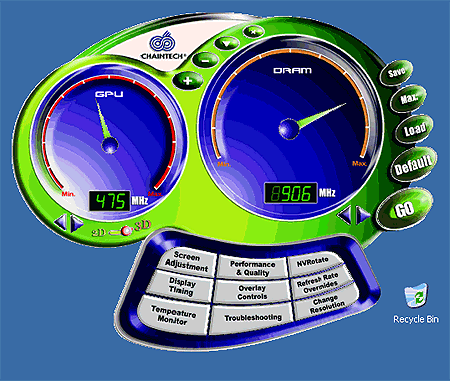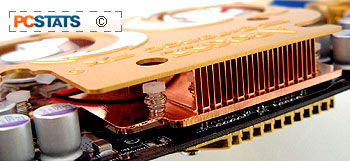Chaintech's GOSU (Graphics Overclocking System Utility) is
one of the most powerful bundled overclockers we have ever played with. Unlike some
overclocking programs from other venders, GOSU is actually extremely
powerful, allowing the end user to push their videocard as hard as they wish!

Under the first analog display on the left there is the 2D/3D slider; make
sure you set that to 3D before you start overclocking. Once that's done, Chaintech's
GOSU will display the default clock speed of the videocard (475/906) and you
can begin to overclock the videocard from there...
The tool also allows you to raise the
core and memory
frequencies independently of each other, but they only move in 1 MHz increments when you click
the appropriate blue directional triangle.
Unfortunately, you'll need to click the triangle for every MHz; so for instance to
raise the core speed from stock to 550MHz you'll need to press the left mouse button
seventy five times! Hopefully newer versions of
Chaintech's GOSU will allow you to simply click and hold, or click and drag the slider
to where you want it
Overclocking the Chaintech
Apogee AA5700U
 It
seems nVIDIA built a lot of headroom into the GeForceFX 5700U core, as the ones
we've played with recently have all been good overclockers. As usual we began overclocking the GeForceFX 5700U core of the
Chaintech AA5700U first, immediately raising its clock speed to 500 MHz. The AA5700U did that without
even breaking a sweat, and after we increased the clock speed to 550 MHz, it was able to
reach a max of 567 MHz before visual artifacts started to appear! Not too shabby considering
we're using Chaintech's stock air cooling!
It
seems nVIDIA built a lot of headroom into the GeForceFX 5700U core, as the ones
we've played with recently have all been good overclockers. As usual we began overclocking the GeForceFX 5700U core of the
Chaintech AA5700U first, immediately raising its clock speed to 500 MHz. The AA5700U did that without
even breaking a sweat, and after we increased the clock speed to 550 MHz, it was able to
reach a max of 567 MHz before visual artifacts started to appear! Not too shabby considering
we're using Chaintech's stock air cooling!
The Chaintech Apogee AA5700U uses 2.2ns Samsung
BGA DDR2 memory (K4N26323AE-GC22
) which we hoped would break the 1 GHz barrier. Going up slowly from
the stock 906 MHz clock speed we easily broke our 1 GHz goal, and in the end topped off
at 1.05 GHz. Very nice indeed!
Curiously, the core and memory on the AA5700U we
tested did not work as well overclocked together, so we were forced to lower
the core overclock from 567 MHz to 550 MHz in order to get the core and memory
to function properly together. For the upcoming benchmarks the card was clocked at
550/1050 MHz for all tests.
 |
| PCStats Test System Specs: |
| processor: |
intel pentium 4 3.0c |
| clock
speed: |
15 x 200 mhz = 3.0
ghz |
| motherboards: |
gigabyte 8knxp, i875p |
| videocard: |
ati radeon 9800xt
ati radeon 9800 pro
ati
radeon 9700 pro
asus radeon 9600xt
msi fx5950 ultra-vtd256
msi fx5900u-vtd256
msi
fx5900xt-vtd128
gigabyte gv-nv57u128d
chaintech apogee aa5700u |
| memory: |
2x 256mb corsair twinx
3200ll |
| hard drive: |
40gb wd special
ed |
| cdrom: |
nec 52x cd-rom |
| powersupply: |
vantec stealth 470w |
| software setup |
windowsxp build 2600
intel inf 5.02.1012
catalyst 3.9
detonator
53.03 |
| workstation benchmarks |
3dmark2001se
codecreatures
aquamark
aquamark3
gun metal 2
x2 the
threat
ut2003
aa test, af and
aa+af test
3dmark2001se
x2 the threat
ut2003 | |
